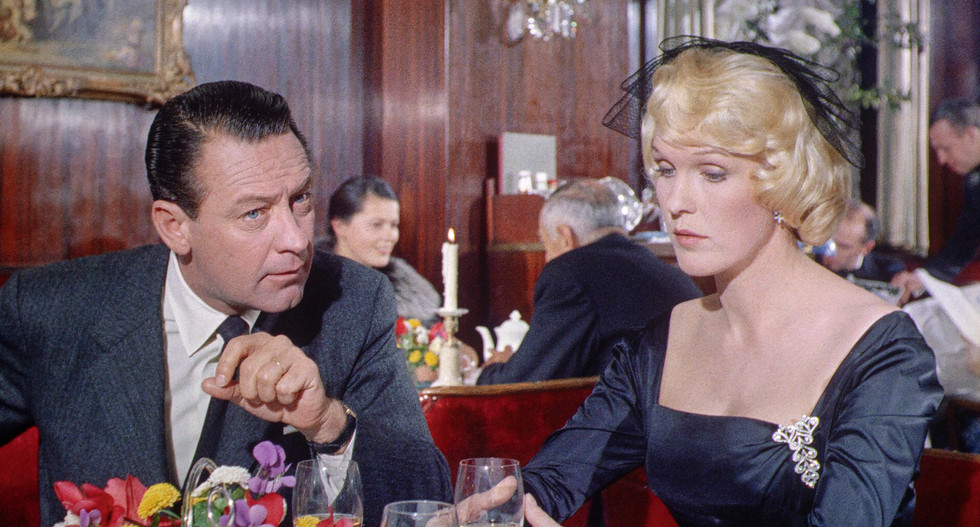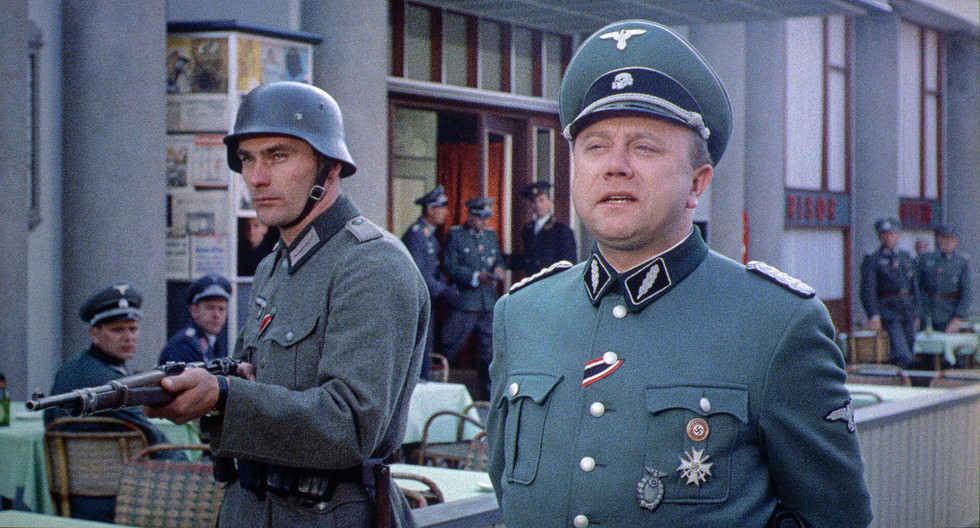Captivating WWII spy drama “The Counterfeit Traitor” from Kino Lorber
- Peggy Earle
- Nov 8, 2022
- 5 min read
Updated: Jan 8, 2023
BLU-RAY REVIEW / FRAME SHOTS

William Holden stars as real-life World War II Allied spy, Eric Erickson. He was an American who became a Swedish citizen and grew rich exporting oil.
(Click an image to scroll the larger versions)
“THE COUNTERFEIT TRAITOR”
Blu-ray; 1962; Not Rated
Best extra: Sole extra is a commentary by film historian/author Julie Kirgo
KINO LORBER presents a film that may not be familiar, even to die-hard cinema buffs, but absolutely deserves a look. “The Counterfeit Traitor” stars William Holden in a seemingly antiheroic role as real-life World War II American spy, Eric Erickson. Written and directed by George Seaton (“Miracle on 34th Street,” “The Song of Bernadette”) and based on the 1958 book by Alexander Klein, the film version recreates much of Erickson’s experiences during the war as written by Klein, but takes its share of liberties as well.
Erickson (Holden) narrates his story periodically, explaining how he became a Swedish citizen and grew rich exporting oil – to both the Allies and the Germans, and profiting from Sweden’s neutrality. When the film begins, he’s more or less being blackmailed by Allied intelligence agents, one of whom is played by the great Welsh character actor, Hugh Griffith. To deliver for the Allies, Erickson must convince those around him, including his wife (Eva Dahlbeck), and his Jewish best friend Max (Ulf Palme), that he’s become a fan of the Nazis. Then Erickson must go to Germany and, with the assistance of a confederate spy he’s to meet there, find out where the Germans have oil depots and refineries so the Allies can destroy them.
Reluctantly, Erickson does what he’s told – but is soon pleased to find out his counterpart in Germany is Marianne Möllendorf (Lilli Palmer), a beautiful socialite – and part of their cover is for them to pretend to be having an affair. The film is a slow-burn thriller with plenty of close calls and harrowingly real scenes. Excellent character studies include that of Erickson, whose eventual transformation from a cynical profiteer to a caring, courageous, empathetic person is quite powerful. Shot almost completely on location, the film is full of fine European actors, such as a young Klaus Kinski.
(1&2) In 1942, Eric Erickson had become headline news in Sweden, blacklisted by the Allies for trading oil to the Nazis. (3) Welsh character actor, Hugh Griffith plays Collins, a British Intelligence agent who recruits Erickson. (4&5) He arrives in Berlin to get information for the Allies to clear his name. He first meets Baron Gerhard von Oldenburg (Ernst Schröder).
VIDEO/AUDIO
This Kino Lorber Blu-ray 1080p transfer was made by Paramount from a recent 4K scan of the 35 mm original negative (1.85:1 aspect ratio). The result is very good, with well-saturated color, satisfying depth, and plenty of fine detail. Strangely, earlier this year Imprint Films based in Australia released "The Counterfeit Traitor" on Blu-ray, but Paramount provided them with an old and worn-out 2K master that's soft and loaded with thousands of marks and scratches. Clearly, KL Studio Classics produced the better restoration.
The DTS-HD Master 5.1 soundtrack is also excellent, with well-balanced sound effects and perfect use of Alfred Newman’s wonderful score. Dialogue, which is primarily in English, along with a bit of Danish, Swedish, and German, is always clear and understandable. English subtitles are provided.

Left, Imprint Film version (2022) from Australia that’s Region Free, but suffers from an inferior old 2K master from Paramount. Right, KL Studio Classics version (2022) is sourced from an excellent 4K scan of the original camera negative from Paramount.
EXTRAS
The commentary by writer/film historian Julie Kirgo is a mixed bag. For the first chunk of the almost two-and-a-half-hour movie, Kirgo provides plenty of interesting background and trivia. She notes that the film was part of a World War II cycle of features during the 1950s and ’60s, such as “The Guns of Navarone,” “The Longest Day,” and “The Great Escape.” The real Erickson, she says, was of Swedish ancestry although born in Brooklyn. He was considered a perfect spy, because “nobody trusted him,” due to his renunciation of American citizenship. Kirgo points out that plenty of American firms, such as Standard Oil, also did business with Germany before the U.S. entered the war.
The film drew criticism from the Hollywood community because it was a “runaway production,” referring to its having been shot on location in Berlin, Hamburg, Copenhagen, and Stockholm, where non-union workers were hired. Theaters that showed the film were picketed. The producer, William Perlberg, defended the location shooting because there were still so many parts of Europe that were bombed out. An actual Nazi prison was used in a few scenes; and the often gloomy, rainy weather required was almost non-existent in Southern California.
(1-3) Erickson pretends to be pro-Nazi with his wife Ingrid (Eva Dahlbeck) and becomes branded a traitor by his friends and countrymen while winning over German officials and military leaders. (4) He meets Marianne Möllendorf (Lilli Palmer), a beautiful Berlin socialite, who becomes part of his cover. (5&6) Erickson heads to Hamburg to enlist the help of his friend Otto Holtz (Carl Raddatz), but his 12-year-old son Hans (Helo Gutschwager) a member of the Hitler Youth questions Eric.
Recreating all that in Hollywood would have been prohibitively expensive. Holden was also a rather controversial figure, as he’d been living in Switzerland to dodge U.S. taxes, and made very few films in Hollywood, yet was one of their highest-paid actors. Kirgo says that Holden was an alcoholic who died in a freak accident at age 63, but that he also cared deeply about wildlife and conservation and did ground-breaking work for those causes.
Kirgo explains which parts of “The Counterfeit Traitor” are based on fact, and which were fabricated. Unfortunately, she also spends a great deal of time describing what’s happening on the screen. Why she (or Kino Lorber, for that matter) imagined that anyone listening to the commentary hadn’t already seen the film – or that they would listen to it before they watched it – is a total mystery. Who on earth needs Kirgo telling you that Holden “walked through the door” right before he walks through a door? Or that an upcoming scene is “hard to watch?” I suspect viewers might consider that an insult to their intelligence.
SIDE NOTE: The import version includes a different commentary with Lee Pfeiffer, publisher of Cinema Reto magazine, with film historian Paul Scrabo, plus a 60-minute documentary “William Holden: The Golden Boy” (1989), that highlights his career, nominations for three Oscars, winning for “Stalag 17” (1953).
— Peggy Earle
(1) Eric and Marianne survive an Allied bombing near her Berlin apartment. (2) Eric tours a German factory where Polish workers have walked out, which leads to several hangings. (3) Eric and Marianne fear for their lives. (4) Marianne thinks she’s confessing to her priest but in reality, it’s the Gestapo. (5&6) Eric and Marianne are both arrested and she’s taken to the Moabit Prison, where he witnesses her execution. (7-9) Eric is released by German officer Col. Nordoff and with help from the German underground, he tries to return to Sweden. In Copenhagen, Denmark he’s spotted by a German officer.









































Comments